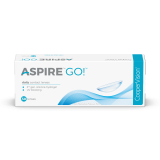
Do you love everything about your contact lenses? Are they as comfortable at the end of the day as they are when you first put them on your eyes in the morning? Are your eyes always bright, winter-white?
It’s OK to be honest—especially with your eye doctor. Discomfort, red or tired eyes, and fluctuating vision can occur with lens wear, but these issues can often be overcome by a simple change in lenses.
Eye Doctors Are Not Mind Readers
More than two-thirds (68%) of consumers say they expect their eye care practitioner to recommend the healthiest option regardless of cost.1 The problem with assumptions, however, is that they work both ways—your doctor may assume that you’re thrilled even though you’re not. Unless you speak up, your doctor can’t know that your lens wearing experience is not meeting your expectations. There are so many different types of contact lenses. If you’re not happy, ask your doctor for an opportunity to trial different lenses.
In a Perfect World
What you should be looking for in a contact lens? Check out the list below and consider where your lenses fall short.
Crisp, clear vision. If your contact lenses had only one job, this would be it. Don’t make compromises with your sight. You shouldn’t need to blink or rub your eyelid to bring your vision into better focus—even if you wear a toric lens for astigmatism. Likewise, if you have presbyopia, you may not need to add reading glasses over your contact lenses. There are several contact lenses that help you see clearly at all distances.
Comfort. For some people, comfort is the greatest hurdle to contact lens wear—especially for those who work long hours and spend a lot of time at a computer. But no matter what your lifestyle demands, your contact lenses shouldn’t be a distraction.
Convenience. Many people choose contact lenses because they’re convenient. However, wearing contact lenses requires a certain level of responsibility. If you wear frequent replacement lenses, it’s essential that you clean and care for them specifically as your doctor instructs. Failing to do so can be detrimental to your wearing experience and can affect your comfort, vision and possibly even your eye health. The only way to free yourself from lens care chores is to ask your doctor if you can be fit with a daily disposable contact lens.
Appearance. Your eyes need to breathe—even when you’re wearing contact lenses. If eyes don’t get enough oxygen, your eyes can develop what’s called hypoxia—which may lead to red eyes. If your eyes don’t look their best, ask your doctor for alternative contact lenses that provides high levels of oxygen performance and may help reduce redness you may be experiencing.
Cost. This is where the rubber meets the road. We want the best of the best, but wonder if we can afford to pay for it. With contact lenses, cost should be viewed from several different angles. First, always consider all the costs and credits for the year. For instance, will you need to buy contact lens cleaning solutions and care products? If so, these are part of the annual expense of wearing contact lenses. Next, if you upgrade your lenses, will you receive any special rebates? If so, you can deduct this from the annual cost of contact lens wear. Finally, consider the value of comfortable, convenient lens wear. If another, slightly more expensive contact lens delivers more of what you need, how much is that enhanced quality of life worth to you?
You only have one pair of eyes, and vision—like time—is priceless. If your contact lenses aren’t performing as well as you hoped, speak up and ask your eye doctor if there is something else that might be suitable.
* If you have any problems with comfort, vision, or redness, remove your lenses and seek advice from your eye care professional.
1 Silicone hydrogel lenses. 2018. YouGov Plc. Total sample size was 1520 adults who wear contact lenses. Fieldwork undertaken Mar 26th-Apr 3rd 2018. Survey carried out online.






